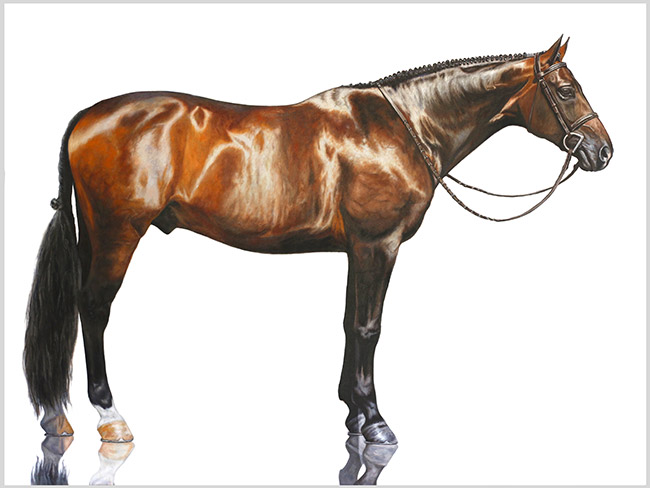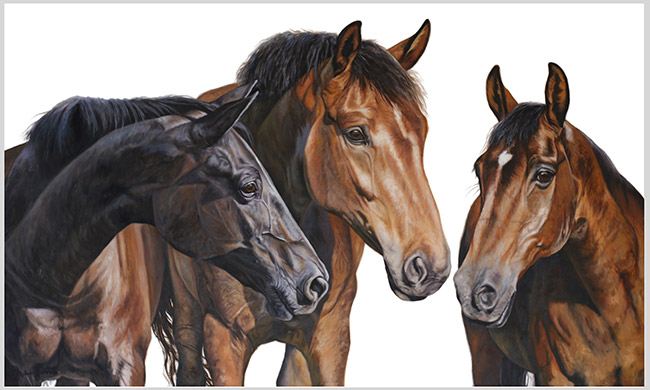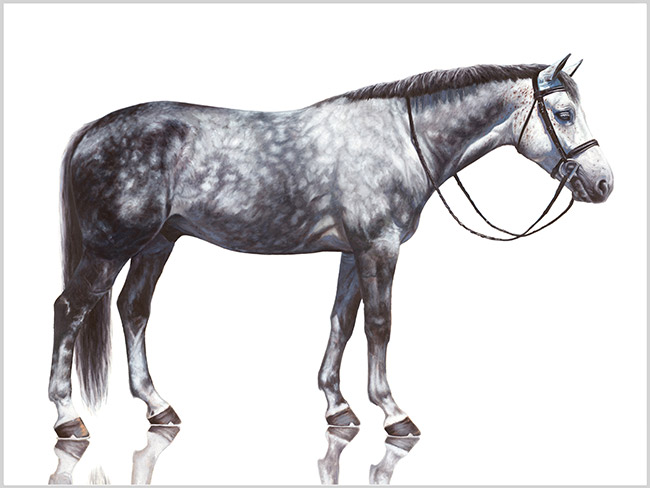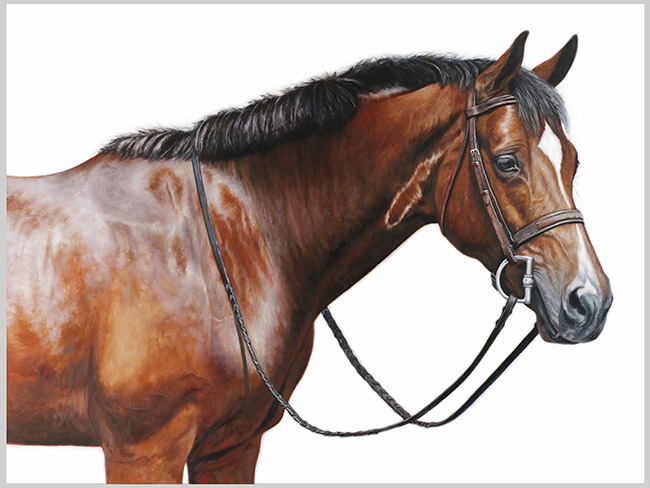You’ve probably seen her work before, maybe on Instagram or elsewhere on social media. Her pieces are striking, powerful, bold, and immediately recognizable. Her name is Julie Ferris, and her work is the future of equestrian art and equine portraiture.

Formal Portrait of Legato
ART AS A LIFESTYLE
As equestrians, we’ve all heard the expression, “Horses aren’t a hobby, they’re a lifestyle.” Ferris agrees with that statement, but she also feels the same sentiment can apply to her career. “Lately, I have discovered that being an artist is a lifestyle. It is a mindset, a way of thinking, and it is an outward expression of who I am and who I want to be.”
Ferris always knew she wanted to be an artist. From elementary through high school, she participated in as many art classes as she could, and she attributes the strong foundation on which her work stands today to those early courses. Also during this time, Ferris was riding often and falling deeply in love with all things equestrian. “Thankfully, my mom enrolled me in a summer horse camp when I was about six, and I have been enamored by and continually drawn to the horse ever since.” She continued to take lessons at a hunter/jumper barn weekly and rode whenever she had the opportunity.
Her love of art and horses led her to The Savannah College of Art and Design (SCAD) where Ferris earned a Bachelor of Fine Arts degree while minoring in Equestrian Studies and competing on the IHSA SCAD Equestrian Team. “Attending SCAD and minoring in Equestrian Studies while riding on the team produced significant growth in me as an equestrian and truly laid an incredible foundation as I graduated to pursue my career as an Equestrian Artist.” After graduation in 2012, Ferris stayed in Savannah for another four years before moving back home to the Northern Metro Atlanta area where she is now painting out of a studio in Historic Downtown Norcross.

Portrait of the Three Girls
THE HORSE AS ART
Ferris focuses strictly on painting horses and would describe her style as contemporary realism inspired by minimalism, realism, surrealism, and impressionism. “For me, I combine both the aspects of fine art and the art of being a rider and an equestrian. I also combine many techniques such as color blocking, glazing, layering, and scumbling. Materials are of paramount importance, and I paint with the finest brands of professional grade oils such as Williamsburg and Sennelier.” Ferris intentionally paints horses on a white background with some texture to add variation because she feels this is the best way to keep the subject the main focus without distractions.
Before she paints, Ferris requires a pre-painting photoshoot to ensure the quality and originality of her work, as well as to meet the horse in person. This time allows her to get a feel for her subject’s personality so she can accurately capture their true essence on the canvas. “Because of my experience through meeting and getting to know a horse from the photoshoot, I can genuinely relate to the portrait on a personal level as I am painting and ultimately create a stronger piece of art.”
Not surprisingly, Ferris gathers inspiration and development as an artist by studying the work of other artists, a few of her favorites being Paul Klee, Wassily Kandinsky, Piet Mondrian, Alfred Sisley, Jean-Baptiste-Camille Corot, Paul Cezanne, and Leonardo da Vinci. “In reference to the Renaissance period and Leonardo’s legacy as a “Renaissance Man,” I like to think of my work as sparking a renaissance or rebirth of the horse in art, seeing the horse as art itself. I challenge myself to bring something new to the table, something different.”
She also notes the wonderful equestrian artists, both past and present, who have influenced her work: Rosa Bonheur, Sir Alfred J. Munnings, James Way, Michael Creese, Susan Leyland, Roberto Dutesco, and Christian Hook. George Stubbs, the prominent equestrian artist of the 18th century who was known to dissect deceased horses in order to better study and capture their anatomy, has both inspired and challenged Ferris. “When I visited the National Gallery in London, I sat in front of his painting, Whistlejacket, for over an hour. Knowing my subject as well as possible is highly important, and Stubbs’ work has influenced me to know the horse both inside and out. I don’t think it is possible to know a subject too well, and I aim to always learn every aspect about horses.”

Portrait of Mojito
ONE PASSION INFLUENCES ANOTHER
Ferris is looking forward to 2017 in which she will continue to create a limited amount of custom work, as well as start a new body of personal work, some of which will be sold at The Grand Bohemian Gallery where she has representation. She will continue to create equestrian works of art that are engaging and original and strive for excellence in all aspects as her business grows.
She will also continue to ride and notes that while she loves riding, it does not come as easy to her as painting. “Painting has always been so natural for me though I know I still have much to learn. Riding, however, is such a challenge. It really stretches me in ways that painting cannot. Pursuing my personal development as a rider is of utmost importance because it is integral to my quest as an equine artist and teaches me more about myself. It all comes full circle because painting horses makes me a better rider as I learn skills of patience, determination, and discipline. Riding makes me a better artist as I practice skills relating to maintaining relationships through communication and sensitivity, self-awareness, concentration, balance, and assertiveness.”
Ferris, quite simply, is captivated by the horse and recognizes the special bond between a horse and its rider. Like most equestrians, she believes that horses make us better people, truer versions of ourselves. Through the use of color, composition, and accurate rendering, Ferris aims to depict and reflect the deep-rooted passion and complexity of the human-horse relationship. Above all, she also shows the love for the essence of the horse and all it symbolizes.

Portrait of Royale
A UNIVERSAL LANGUAGE
Running her own business is very time-consuming, but Ferris makes sure she sets time aside for riding, visiting with family and friends, and playing the piano. She also enjoys going on walks with her dachshund Gretchen Wieners, her “studio assistant” who keeps her company while she paints. Ferris is also quick to give thanks to God for giving her the gift of artistic talent and blessing her with family, friends, teachers, and clients who have helped and supported her since the beginning.
Ferris says one of her greatest accomplishments is having a job that brings her joy. She has worked hard to get to this stage where she has a great portfolio of work, both personal and custom, and she has patrons who believe in and value her work. She knows there is a connection between horses and art that will last forever.
“Art engages and challenges people, and above all, it communicates something – it’s a universal language. The horse has been an integral part of human history since the beginning; as societies and cultures developed, you find that the horse played a vital role. When I create a painting of the horse, it’s more than that; it is the idea, the mystery, the essence, as well as the rich history they have been a part of, influenced by my own personal experience. By creating works of art that showcase the horse, I am communicating a message that connects with equestrians all over the world and will speak to future generations.”
julieferrisart.com
IG: @julieferris_equine_artist


Leave A Comment
You must be logged in to post a comment.